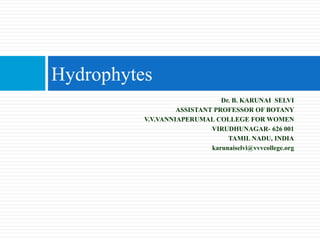Hydrophytes classification
- 1. HYDROPHYTES
- 2. Dr. B. KARUNAI SELVI ASSISTANT PROFESSOR OF BOTANY V.V.VANNIAPERUMAL COLLEGE FOR WOMEN VIRUDHUNAGAR- 626 001 TAMIL NADU, INDIA karunaiselvi@vvvcollege.org Hydrophytes
- 3. In relation to water, soil and air the hydrophytes are grouped into 1. Submerged hydrophytes 2. Floating hydrophytes 3. Amphibious hydrophytes HYDROPHYTES - CLASSIFICATION
- 4. 1. Submerged hydrophytes Submerged hydrophytes are • Plants which grow below the water surface. • They not have contact with atmosphere. • They have contact only with water. • They may be free floating and / or rooted. • Submerged hydrophytes are two different types, They are • Submerged floating hydrophytes • Rooted hydrophytes
- 5. They are non- rooted plants suspended in water. They are not – having contact with soil and water. Generally they are devoid of roots. (eg.) Ceratophyllum , Utricularia Submerged floating hydrophytes Ceratophyllum
- 6. These plants have roots. Grow entirely under water. Root system is poorly developed. Leaves are small scale like or ribbon like. Roots absorb nutrients from soil. (eg.) Hydrilla ,Vallisnaria Rooted hydrophytes: Vallisnaria
- 7. C.S. of Hydrilla Stem Under compound Microscope Section taken by III B.Sc., Zoology Students
- 8. C.S. of Hydrilla Stem Diagramatic representation of cross section of Hydrilla stem By Ms. V. Jeyalakshmi, III B.Sc. Zoology, VVV College, Virudhunagar
- 9. 2. Floating hydrophytes These plants float on the water surface or slightly below the water surface. They have contact with both water and air. Floating hydrophytes are two different types: Free floating hydrophytes Rooted floating hydrophytes
- 10. These plants float freely on the water surface. They are not rooted on the mud. They have contact with water and air. They have roots, roots hairs and root pockets. (eg.) Eicchornia, Pistia a) Free floating hydrophytes Pistia
- 11. Roots are fixed in a mud. But leaves and flowers float on the water surface. Petioles are long and suspended in water. Stem maybe either rhizome or stolen (eg.) Nymphaea. b) Rooted floating hydrophytes:
- 12. 3. Rooted emergent hydrophytes These plants are adapted to both aquatic and terrestrial modes of life. They grow in shallow water or on muddy substratum. Shoots grow and extend above the surface of water. Roots are fixed in muddy soil. Submerged parts have hydrophytic character. Exposed parts have mesophytic or xerophytic character. These are called amphibious hydrophytes. (eg) Sgittaria, Marsilea
- 13. Rooted emergent hydrophytes Sgittaria Marsilea
- 14. References https://www.plantsrescue.com/ceratophyllum- demersum/ https://www.pondplantsonline.com/products/va llisneria-vallisneria- americana?variant=7621583109 https://www.colourbox.com/image/beautiful- pink-water-lily-image-13932261 https://www.flickr.com/photos/dweickhoff/5187 617361













